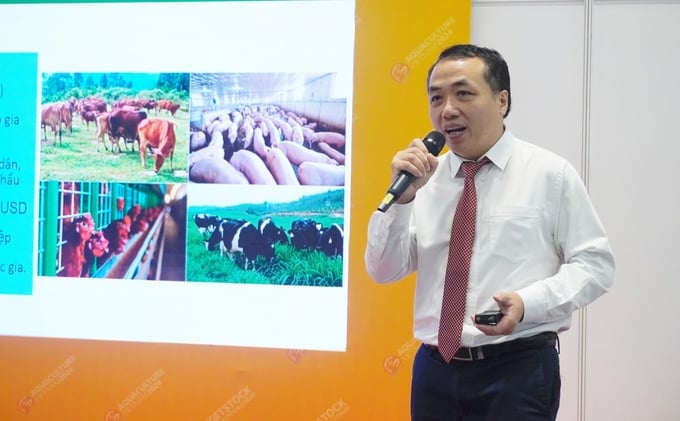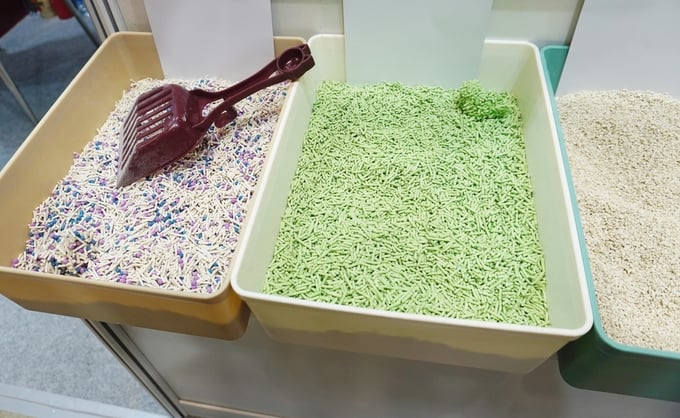November 19, 2025 | 08:10 GMT +7
November 19, 2025 | 08:10 GMT +7
Hotline: 0913.378.918
November 19, 2025 | 08:10 GMT +7
Hotline: 0913.378.918

Dr. Vo Trong Thanh, Department of Livestock Production (Ministry of Agriculture and Rural Development) said that the livestock industry is an important pillar of Vietnam's agricultural sector. Photo: Hong Tham.
The workshop "Nutrition and animal feed technology in the new context: Trends and Innovations" was recently held in Ho Chi Minh City within the framework of the Vietstock Expo and Forum 2024. At the event, Dr. Vo Trong Thanh, Department of Livestock Production (Ministry of Agriculture and Rural Development) said that the livestock industry is an important pillar of Vietnam's agricultural sector.
In 2023, the livestock industry achieved a growth rate of 5.72% and over the past 10 years, the industry has always maintained a growth rate of 4 - 6%. The total revenue of the livestock industry in 2023 reached over USD 33 billion, contributing 26% to agricultural GDP and over 5% to the national GDP. In the period 2019 - 2023, the total herd of pigs, poultry, and cows all experienced growth, only the herd of buffalo showed signs of decline. As the livestock herd increased, there were also more demands for animal feed.
Animal feed production has become a very important component of the livestock industry. “Livestock output has increased a lot but animal feed has only doubled its output because animal feed is getting better and better, with higher quality to create more livestock products per unit of animal feed, or in other words, the feed conversion ratio (FCR) is showing improvement”, said Dr. Vo Trong Thanh.
Currently, Vietnam ranks seventh in the world in terms of animal feed output, after China, the USA, Brazil, India, Mexico, Russia and Spain. In the period 2019 - 2023, the number of complete factories of mixed animal feed in Vietnam has not changed much, ranging from 260 to 270 factories, producing nearly 21 million tons of complete mixed animal feed. This shows that animal feed factories are optimizing operations, thereby increasing productivity and quality.
The global animal feed industry will focus on 10 key trends:
Shifting towards value chain linkage; Sustainable feed production practices; Technological advances in nutritional needs analysis; Strengthening animal feed management standards, safety and emission reduction;
Integrating digital solutions, digital technology (AI) and the Internet of Things (IoT) in optimizing animal feed formulation/production; Animal feed control process adapting to climate change; Focusing on animal welfare and product traceability;
Limiting or ceasing the use of antibiotics to prevent disease in animal feed production; Reducing packaging costs through automatic feeding systems; Wider usage of herbs, enzymes, probiotics, and organic acids.
In the case of Vietnam animal feed production development in the next 5 years may follow five trends: Animal feed output will be relatively stable, or only increase slightly by 1 - 3% per year. Competition for quality is increasingly fierce among animal feed production enterprises. New production technology and automation are being paid more attention to and widely applied. Demand for pet food continues to increase, estimated at 12.2%/year in the period 2023 - 2029. Herbal products, probiotics, and organic acids replace antibiotics in animal feed.
Dr. Vo Trong Thanh also pointed out seven major challenges faced by the animal feed production industry in Vietnam at the workshop.
The most visible challenge is the dependence on imported raw materials. The USD/VND exchange rate is quite high, increasing production costs. Logistics costs for importing animal feed are high, increasing by 15 - 20% compared to before Covid-19, with no signs of decreasing. High costs in the production, marketing, and distribution of animal feed products remain unsolved.
The total livestock herd fluctuates greatly due to poor biosecurity in livestock farming and difficulties in disease control. The chain linkage in livestock production is weak, constantly interrupted, and unsustainable. Supply is unstable and prices of animal feed ingredients increase due to geopolitical tensions and military conflicts around the world.
Contrary to the situation, this industry still has many opportunities, such as the large scale livestock farming and consumption market. Import and export procedures are quite favorable and open. Raw materials for animal feed enjoy maximum exemption and reduction of import tax rates. There are policies to support enterprises producing animal feed. Institutional policies and legal procedures are increasingly improved and optimized, highly integrated, and have the potential to export animal feed to close regions and the world.

The demand for pet food in Vietnam is forecast to continue an uptrend, estimated at 12.2% per year in the period 2023 - 2029. Photo: Hong Tham.
The Ministry of Agriculture and Rural Development is implementing solutions to develop the animal feed production industry in the near future under the Scheme on Developing the Animal Feed Processing Industry to 2030, which has been approved by the Prime Minister.
The Scheme opens up three main groups of solutions: Developing and innovating the level of industrial animal feed production technology in areas with livestock development orientation; Developing the industries of supplementary feed production, agricultural by-products processing, and animal feed in general; Converting part of agricultural land area to produce animal feed raw materials to meet domestic demand and limit imports.
The Ministry of Agriculture and Rural Development has recently decided to establish two centers, including the Central Livestock Testing, Inspection and Certification Center I located in Hanoi and the Central Livestock Testing, Inspection and Certification Center II in Ho Chi Minh City with the functions of analysis, testing and certification, and training and consulting. The goal is to create a premise to support businesses in improving the quality and efficiency of animal feed production.
“Competition on quality will become increasingly fierce among animal feed production enterprises in the future, thus requiring enterprises to innovate in technology, management methods and many related issues to optimize costs and improve business efficiency,” said Dr. Vo Trong Thanh.
Translated by Samuel Pham

(VAN) Deputy Prime Minister Tran Hong Ha convened a meeting with the MAE and relevant agencies to discuss the draft decree on national multidimensional poverty standards for the 2026 - 2030 period.

(VAN) The year 2025 marks the 10th anniversary since more than 190 countries adopted the Paris Agreement on climate change, paving the way for strengthened global action.

(VAN) The PepsiCo Foundation funded the project ‘New Harvest: Sustainable Agriculture Initiative’, focusing on regenerative agriculture and climate change.

(VAN) Dr. Nguyen Viet Hung, ILRI's Regional Director for Asia, emphasized the One Health approach in ensuring food safety and reducing antimicrobial resistance risks in livestock.

(VAN) The youth-driven initiative ‘Innovate for water, act for the future’ seeks practical, scalable solutions to Vietnam’s water challenges.

(VAN) At the Annual Science Conference of Thuyloi University, Deputy Minister Phung Duc Tien directed researchers to focus on in-depth studies, data harmonization, and solutions linked to real-world practice.

(VAN) After nearly four years of implementation, 5,187 community agricultural extension groups have been established nationwide, with 47,493 members participating.